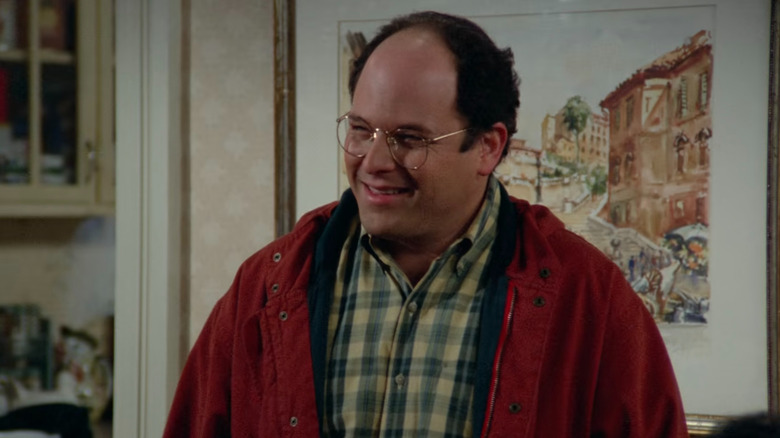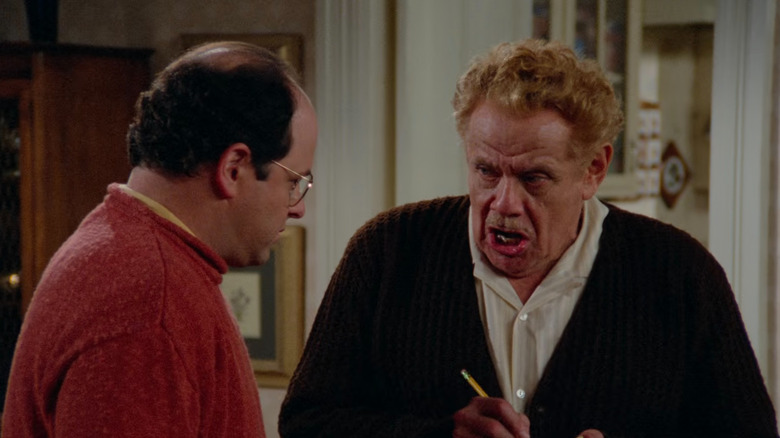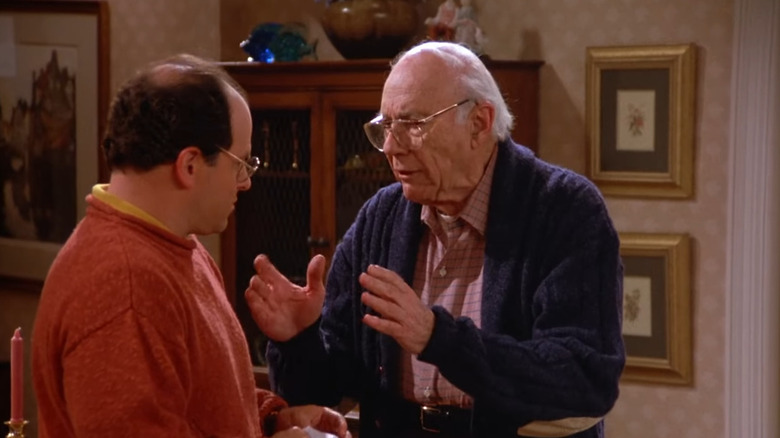Several Seinfeld Scenes Were Reshot To Feature A Major Guest Star
"Seinfeld" is often regarded as one of the greatest sitcoms of all time, and for good reason. Created by Larry David and Jerry Seinfeld, the hit NBC comedy was unlike any other show on television. It consistently kept taking risks with its plots, stories, structure, and, most importantly, jokes. A wealth of talented writers, coupled with its exceptionally funny ensemble cast, boosted "Seinfeld" from just another laugh track-laden comedy into prime water cooler television. But it didn't happen all at once. The series shared a commonality with a lot of great NBC sitcoms, such as "The Office" and "Parks and Recreation," in that its first season was still figuring out its sense of identity. While each subsequent season would embolden the series' confidence in itself, there were still some hiccups along the way regarding the casting of smaller, important roles.
Phil Bruns was the first actor to play Jerry's dad, Morty, in the series' second episode, "The Stakeout." The "Mary Hartman, Mary Hartman" star was ultimately recast because his understated performance didn't play well. David and Seinfeld wanted a more curmudgeonly presence in the role, so Barney Martin served as his replacement in the following season ("The Pony Remark") and played Morty for the rest of the series. It's pretty funny this isn't the only time a parental figure of a core "Seinfeld" character was replaced by another actor after a single appearance.
In the season 4 episode, "The Handicap Spot," George Costanza (Jason Alexander) finds himself in a predicament when he borrows his father's car — only to have it comically vandalized after pulling a last-minute parking job in a handicap spot. He naturally attempts to lay the blame elsewhere, but it comes back to bite him when dad receives the brunt of it during a ceremony celebrating his work with the handicapped. Frank Costanza's inaugural appearance featured actor John Randolph as the father of his inconsiderate offspring. This was yet another case where, despite being a good actor, he just didn't feel right in the part. Jerry Stiller was brought in at the suggestion of writer Larry Charles for his sophomore appearance in season 5's "The Puffy Shirt" and all the way until the series' end. In the meantime, syndicated reruns of "The Handicap Spot" didn't help with the transition in Larry David's eyes.
John Randolph's scenes as Frank Costanza were reshot to accommodate Jerry Stiller
Stiller may have fit Frank like a glove, but whenever the character's first appearance kept getting shown in syndication across the next few years, it would be Randolph's footage. In a DVD featurette, Larry David talks about how the inconsistency between actors prompted him to reshoot Frank's scenes with Stiller to further illustrate his permanence in the role:
"Because of the syndication, they would keep rerunning 'The Handicap Spot' with John Randolph and it would seem odd that George would have two different fathers. So I prevailed upon Castle Rock and NBC to let me reshoot those scenes with John Randolph and replace him with Jerry Stiller, which is what we did."
David wanted to do the same thing for Morty's transformation from Bruns to Martin, but so much time had passed and everyone already looked so different since season 1 that it would have been too distracting. But doing it for Stiller illustrated why the casting shift was a necessary one. In a YouTube video playing scenes from both actors doing the same scenes back-to-back, it shows Randolph didn't have much comedic chemistry with his onscreen son; he exudes a much older and slightly warmer presence (barring the head bonking). Fans of "Seinfeld" laud Stiller's performance because he's able to go toe-to-toe with Alexander. His hilariously antagonistic delivery of "de-li-ver it to her" says everything.
Stiller's heightened interactions with Alexander in "The Handicap Spot" reshoots paint a very clear picture as to why George is the way he is. It's easy to see how he became a neurotic mess growing up in the company of his folks. Stiller, and Estelle Harris as Costanza matriarch Estelle, no doubt fit the mold of these characters perfectly. They were an unstoppable sitcom couple who bolstered the series every time they made a guest spot. As for Stiller and Randolph's renditions of Frank, this episode serves as a great case study of how two actors can approach the material in significantly different ways. If not for the existing footage, this could have been another case of the Mandela effect confounding audiences as to whether Stiller was there the whole time. Festivus wouldn't be the same without him.
Jason Alexander and Jerry Stiller worked with John Randolph prior to Seinfeld
Part of what made Randolph's exit from the series so conflicting for Alexander and Stiller is that both actors previously had a professional correspondence with him in other projects. Alexander admired him, having worked together on Broadway, while acknowledging that he wasn't right as the Costanza patriarch (via DVD featurette):
"He had played my grandfather in Neil Simon's 'Broadway Bound' and John was 72 when we did the play. And here we were several years later so I knew John was in his late seventies. John is a Jewish man, but he never looked it. He had a very sort of WASP-y patrician look. He didn't look like me, and he didn't look like a Costanza."
Keeping with patterns, it turns out Stiller also had his share of wonderful run-ins with Randolph across his lifetime. He was so enamored with the actor's performance in the Broadway production of "Command Decision" that he had to express his admiration, where Randolph gave simple words of advice concerning his acting career. Words were even exchanged about Stiller possibly working with him someday. It turns out they did, even though it made taking over his "Seinfeld" role momentarily awkward (via DVD featurette):
"I actually did work with him at the Phoenix Theater and he was blacklisted. He went through hell, didn't work for years, and then when he did finally come back, here I was replacing him in this show. I had very mixed feelings, but not for long [laughs]."
On top of swiping a gig from someone you admire, it must have been hard to take work away from Randolph, who was just starting to come back into the spotlight. In 1955, The Tony award-winning actor was called before the House Un-American Activities Committee during the reign of McCarthyism, where his invoking the Fifth Amendment caused him to get blacklisted from the industry for some time. Randolph would find his way back with roles in "Serpico," "Earthquake," and "National Lampoon's Christmas Vacation," with his final bow being the romantic comedy "You've Got Mail."
Every episode of "Seinfeld" is currently streaming on Netflix.


